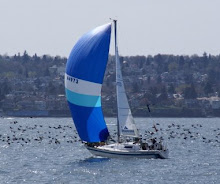 In the previous post you saw an aerial photo and a ground level view of Mount Baker, a volcano in the Cascade Mountains. My apartment faces east allowing me to see this mountain from my window. There is a great view of the volcano from the corner of my balcony. Late 2005 and into 2006 there was an eruption of Mt. Augustine (Augustine Island) in Alaska. The Augustine Volcano is known as a stratovolcano, as are Mt. Baker, Mt. Rainier and a number of other volcanoes in the Cascade Range. They are the explosive kind. Mt. St. Helens is another good example. The above map and the photos of the eruption are from the Alaska Volcano Observatory. Go to http://www.avo.alaska.edu/volcanoes/volcimage.php?volcname=Augustine&search_year=2006 for further information and photos. Below are a few photos of the Augustine Volcano in action in January 2006.
In the previous post you saw an aerial photo and a ground level view of Mount Baker, a volcano in the Cascade Mountains. My apartment faces east allowing me to see this mountain from my window. There is a great view of the volcano from the corner of my balcony. Late 2005 and into 2006 there was an eruption of Mt. Augustine (Augustine Island) in Alaska. The Augustine Volcano is known as a stratovolcano, as are Mt. Baker, Mt. Rainier and a number of other volcanoes in the Cascade Range. They are the explosive kind. Mt. St. Helens is another good example. The above map and the photos of the eruption are from the Alaska Volcano Observatory. Go to http://www.avo.alaska.edu/volcanoes/volcimage.php?volcname=Augustine&search_year=2006 for further information and photos. Below are a few photos of the Augustine Volcano in action in January 2006.


The map below comes from the USGS and shows the volcanoes in the Cascade Range. These continue north into the Coast Mountain Range in British Columbia (Canada). If you do a Google search for "volcanoes", "statovolcanoes" or related searches, you will come up with all sorts of information.
Last evening I did a search for hazard maps for Mt. Baker and Mt. Rainier. The two maps below are the result of that search. When a volcano erupts, there is not only steam venting but there could also be hot ash, flood waters from melting glaciers, mud plus lava. It all depends on the severity and the wind direction as to the land area affected. Personally, I believe forewarned is forearmed. There is less need to panic if a person has escape routes planned and has information on hand on what might be expected. There has been alot of talk to suggest that animals head for higher ground before such events take place. As intelligent as we might think we are, we might benefit from watching how the birds animals are reacting and take heed.


Below is a photo (from Wikipedia.org) of the island of Tenerife in the Canary Islands in the Atlantic Ocean off the west African coast (Morocco, etc). The dominant feature from the air is Pico de Teide, another stratovolcano of note. There are other welknown stratovolcanoes as well such as Mt. Etna in Sicily (Italy), Mt. Vesuvius (Italy) and Santorini (Greece). Some volcanoes are also known as Decade Volcanoes. Do some research and see what you find in both information and photos. It's a journey of adventure and enlightenment!
There will be more of my own photos coming up soon. I hope you have benefitted from this post and what it has to offer. Comments as usual are always welcome.



No comments:
Post a Comment